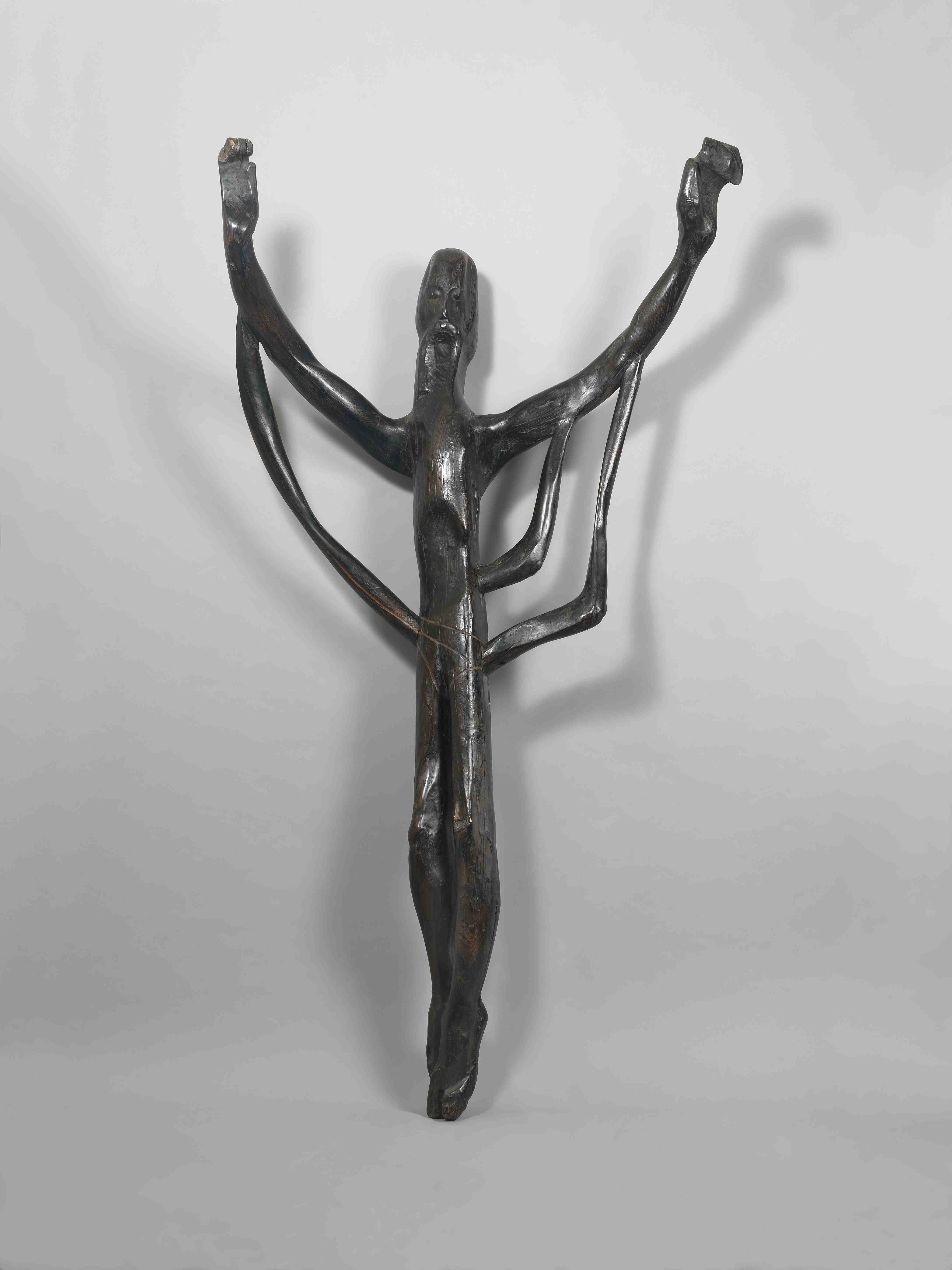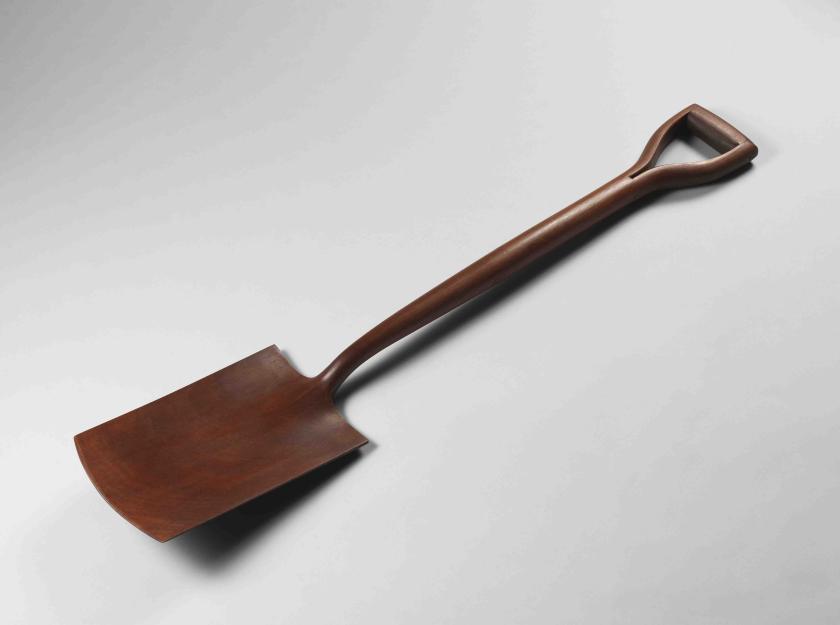Carving in Britain from 1910 to Now is an accurate but unalluring title for what is a seminal show. The Fine Art Society is one of the oldest commercial galleries in Britain, founded in 1876 and still in its original building. Due to this longevity the FAS has unusual access to private collections, and an ability to mix the historic and contemporary to fine effect. The result here showcases an original anthology, simultaneously scholarly and commercial, a mix of loans and for-sale.
The collection is a striking complement to the Royal Academy’s dazzling exploration of millennia of bronze, and should probably also be borne in mind when Ice Age Art, featuring the earliest carvings, a mere 40,000 years old, arrives at the British Museum in February. Henry Moore features in all three. At the FAS there is his small yet monumental Composition, 1931, in semi-translucent alabaster (that material so fundamental to medieval carving), its form suggestive of a richly embracing maternal figure, alert and tender.
 The compass is wide. The Welsh mystic David Jones, noted not only for his magnificent poetry but for his enchanted large scale watercolours, is here represented by two boxwood printing blocks, The Church on the Rock and, rather improbably, a mid 19th-century scene in black and white of Abraham Lincoln - yes, in a theatre. The master letterer David Kindersley, Eric Gill’s last apprentice, is here with a quote from Keats carved into limestone, the letters painted red; a sign in Portland stone for the British Film Institute; and a powerful female torso, Angel Bust.
The compass is wide. The Welsh mystic David Jones, noted not only for his magnificent poetry but for his enchanted large scale watercolours, is here represented by two boxwood printing blocks, The Church on the Rock and, rather improbably, a mid 19th-century scene in black and white of Abraham Lincoln - yes, in a theatre. The master letterer David Kindersley, Eric Gill’s last apprentice, is here with a quote from Keats carved into limestone, the letters painted red; a sign in Portland stone for the British Film Institute; and a powerful female torso, Angel Bust.
The workshop flourishes now, producing bespoke memorials and individual work. Lida Cardozo Kindersley suggests we "Hasten Slowly" in slanted golden letters carved into slate. Richard Kindersley is a ubiquitous designer of lettering, from the Museum of Scotland to St Paul’s (where his father David did the Falklands memorial), and here his apprentice alphabet, made when he was 20, makes of each letter a thoughtful marvel. His carving of phrases from Philip Larkin on Welsh slate – “This is the first thing / I have understood / Time is an echo of an axe / Within a wood” - transforms the poem into something hauntingly and physically expressive.
 A significant number of these artists are polymaths. Eric Gill (1882-1940), himself the leader of the early 20th century revival of both carved lettering and stone sculpture, created in the context of his singular artistic communities and workshops, is shown with a range of work: workshop-carved stone capitals for the wooden columns of his community chapel; subtly erotic Petra Bathing (pictured above right), the young girl contained in her snugly fitting tub; flirtatious Headdress, the female torso emerging from its stone base, her smiling red lipped face crowned by a burst of hair, coyly looking sideways; and a 1907 inscribed foundation stone from a Suffolk rectory. Gill invented some of the most lasting fonts – perpetua, gill sans – and his Ariel and Prospero still grace Broadcasting House and his North, South and East Winds London Transport headquarters.
A significant number of these artists are polymaths. Eric Gill (1882-1940), himself the leader of the early 20th century revival of both carved lettering and stone sculpture, created in the context of his singular artistic communities and workshops, is shown with a range of work: workshop-carved stone capitals for the wooden columns of his community chapel; subtly erotic Petra Bathing (pictured above right), the young girl contained in her snugly fitting tub; flirtatious Headdress, the female torso emerging from its stone base, her smiling red lipped face crowned by a burst of hair, coyly looking sideways; and a 1907 inscribed foundation stone from a Suffolk rectory. Gill invented some of the most lasting fonts – perpetua, gill sans – and his Ariel and Prospero still grace Broadcasting House and his North, South and East Winds London Transport headquarters.
Henri Gaudier-Brzeska’s bath stone Crouching Faun, 1913, was made two years before he was killed, aged 24, in the senseless slaughter of the war. It points up one of the most poignant might-have-beens in art; his faun is so touchingly young.
Barbara Hepworth is here with two geometric forms in white alabaster, as well as her first husband John Skeaping with Crucifix, 1953-4 (pictured above left), and an abstracted art deco duck and pig in reddish serpentine. Stone proves a responsive medium for the intuitive geometry of Peter Randall-Page’s By Another Ocean I and II, 1998, boulders curved like static waves. Tim Pomeroy’s String, 2007, in carrera marble is seemingly just that, a column of winding, well, string. Gavin Turk’s 2003 Desert Island Scenario (see main image), a spade carved in mahogany, is in the window, while the trompe l’oeil heaps of folded marble T-shirts with their mottos, Skill, Strength, Courage, Health, Wisdom, Speed, 2009, by Alexander Seton, are charmingly ridiculous and quite serious, like grave goods for a modern mausoleum, what the well-dressed hippie might wear in the afterworld. Andreas Blank, exploiting deadpan irony, simply carves a bin bag in black serpentinite for Untitled, 2012. In Still Life, 2012, a green light bulb emerges from a white marble box.
The FAS exhibition presents a huge subject in comprehensible, digestible form, reminding us that the profoundly expressive possibilities of using chisel and knife on stone and wood are still pertinent.









![SEX MONEY RACE RELIGION [2016] by Gilbert and George. Installation shot of Gilbert & George 21ST CENTURY PICTURES Hayward Gallery](/sites/default/files/styles/thumbnail_125_x_125_/public/mastimages/Gilbert%20%26%20George_%2021ST%20CENTURY%20PICTURES.%20SEX%20MONEY%20RACE%20RELIGION%20%5B2016%5D.%20Photo_%20Mark%20Blower.%20Courtesy%20of%20the%20Gilbert%20%26%20George%20and%20the%20Hayward%20Gallery._0.jpg?itok=3oW-Y84i)





Add comment